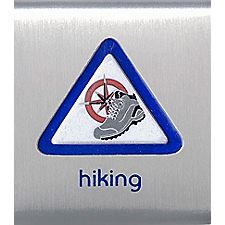This sport was added in 2009.
Requirements
Tiger Cubs, Cub Scouts, and Webelos Scouts may complete requirements in a family, den, pack, school, or community environment. Tiger Cubs must work with their parents or adult partners. Parents and partners do not earn loops or pins.
Belt Loop
Complete these three requirements:
- Explain the hiking safety rules to your den leader or adult partner. Practice these rules while on a hike.
- Demonstrate proper hiking attire and equipment.
- Hike at least 30 minutes with your adult partner, family, or den.
Sports Pin
Earn the Hiking belt loop, and complete five of the following requirements:
- Make a chart and record at least five hours of hiking.
- Help plan a den, pack, or family hike.
- Earn Cub Scouting’s Leave No Trace Awareness Award.
- Earn the Cub Scout Outdoor Activity Award.
- Learn seven trail signs and tell your den leader or adult partner what they are.
- Be able to identify five different trees and five different birds on your hike. (These can be of the same species if multiple species are hard to find.)
- Using pictures or photographs, identify three poisonous plants. (Examples are poison ivy, poison sumac, and poison oak; oleander, poinsettia, etc.). Watch for these plants while on a hike.
- Take two different hikes for different purposes, for example, a nature hike, neighborhood hike, historical hike, city hike, stop-look-and-listen hike, and so on.
- Explain to your den leader or adult partner what a compass is and show how to use one on a hike.
- Explain to your den leader or adult partner what a global positioning system is and demonstrate how to use one on a hike.
- With visuals such as pictures or maps, report about one of your hikes to your den. Tell about how you prepared for your hike, who went with you, and what you saw.
Hiking Safety Rules:
- Always tell someone where you are going and when you will return.
- Never hike alone or at night; always use the buddy system.
- Dress properly for the weather and environment.
- Wear sun and insect protection.
- Take an extra pair of socks in case you need to change.
- Obey traffic signs and signals.
- Avoid hiking along roadways.
- Stay on the trail.
- Be alert to your surroundings.
- Don't litter as you hike.
- Be alert to dangerous animals, insects, and plants. Never touch a wild animal.
- Take 1 pint of water for each hour you will be hiking. Never drink untreated water.
| Worksheets for use in working on these requirements: | Word Format | PDF Format |








